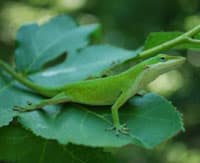Genetic map of the green anole produced for the first time
The green anole lizard (Anolis carolinensis) – a native of the southeastern United States – is the first reptile to have its genetic blueprint, known as a genome, sequenced and assembled. Broad Institute researchers have studied more than 20 mammalian genomes – including those of some of our closest relatives – but the genetic landscape of reptiles has remained relatively unexplored.
Lizards are more closely related to birds than to any of the other groups whose genomes have been sequenced in full. “People have been sequencing animals from different parts of the vertebrate tree, but lizards had not been previously sampled,” explained Kerstin Lindblad-Toh, scientific director of vertebrate genome biology at the Broad who has been closely involved in the research. “This was an important branch to look at.”
Amazing Diversity
Four hundred species of anole lizards have fanned out across North America, Central America, the islands of the Caribbean and South America, making them an appealing model for studying evolution. Although much is known about their biology and behavior, genomic information may be a critical missing piece for understanding how the lizards have become so diverse.
“Anoles are rich in ecology and morphology and have just the right amount of diversity to make them interesting yet tractable to study,” said Jonathan Losos, an author of the paper, professor at Harvard University, and author of the book Lizards in an Evolutionary Tree: Ecology and Adaptive Radiation of Anoles.
“But a big stumbling block in studying them has been that they have not been great organisms for classical genetic study. This genome is going to revolutionize our ability to study that aspect of their evolutionary diversification.”
In addition to insights into human and mammalian genomes, the anole lizard’s genome also offers up clues about how lizard species evolved to populate islands in the Greater Antilles. Much like Darwin’s finches, anoles adapted to fill all of the ecological niches the islands have to offer.
Some lizards have short legs and can walk along narrow twigs; others are green in color with big toe pads suited for living high up in trees; others are yellow and brown and live in the grass. But unlike the finches, lizards on different islands have independently evolved diverse communities of these twig, canopy, and grass dwelling species – almost identical lizard species have evolved in parallel on the islands of Hispaniola, Puerto Rico, Cuba, and Jamaica.
“These lizards have been compared to Darwin’s finches and in many respects they are similar,” said Losos. “They show the workings of natural selection as species adapted to different habitats. But the difference is in the case of the lizards, this evolution has happened four times, once on each of the different islands.”
By sampling the genomes of more than 90 species, the researchers were able to make a preliminary map of how these species evolved to colonize the islands. “This is setting the stage for the research community to be able to look for signatures of adaptation in a very informative and coherent way,” said Lindblad-Toh.
Color Vision
The researchers were also able to create a “parts list” of proteins found in green anole eggs, which they compared with those found in eggs from chickens and they discovered that both bird and lizard egg genes are evolving rapidly. They also mapped many genes in the anoles’ genome associated with color vision, which these lizards use to identify mates.
“Anoles have extremely good color vision – some species can even see in the ultraviolet range,” said Losos. Other studies have shown that anoles can distinguish between similar colors and patterns. “It’s pretty clear that one function of the dewlap is to distinguish one species from others and that they use the dewlap – the skin fold under the chin – to determine whether a particular individual belongs to their species or not.”
Reference: Alfoldi J et al. “The genome of the green anole lizard and a comparative analysis with birds and mammals.” Nature August 31, 2011 doi:10.1038/nature10390




